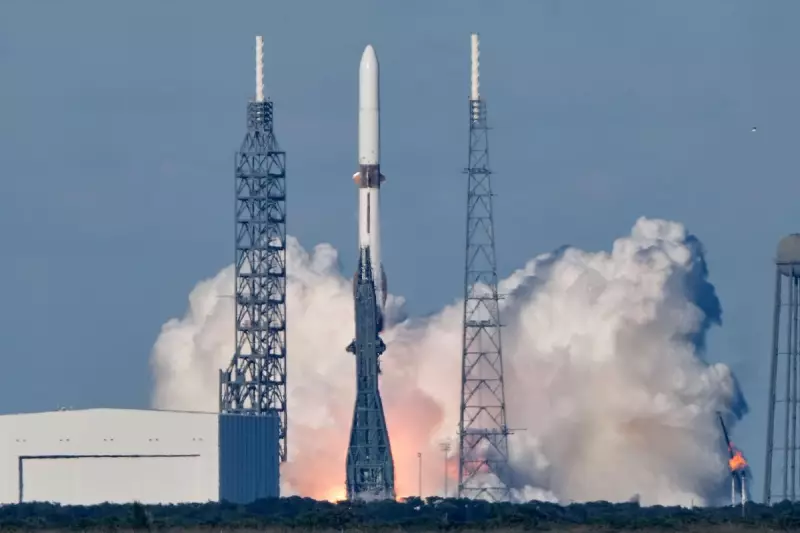
In a significant breakthrough for private spaceflight, Jeff Bezos' company Blue Origin has successfully launched its colossal New Glenn rocket, carrying a pair of NASA spacecraft destined for Mars. The launch, which had been delayed for four days by adverse weather and intense solar storms, represents only the second flight for the vehicle that both Blue Origin and NASA are relying on for future lunar missions.
A Triumphant Launch After Solar Delays
The 321-foot (98-meter) New Glenn rocket blasted into the afternoon sky from Cape Canaveral Space Force Station, finally getting airborne after liftoff was stalled by lousy local weather and solar activity so strong it painted the skies with auroras as far south as Florida. An ecstatic Jeff Bezos watched the proceedings from Launch Control as the rocket carried NASA's twin Mars orbiters, named Escapade, on the beginning of their drawn-out journey to the red planet.
In a remarkable and essential step towards reusability and cost reduction—a strategy famously pioneered by rival SpaceX—Blue Origin successfully recovered the rocket's booster following its separation from the upper stage and the Mars orbiters. Company employees cheered wildly as the booster made an upright landing on a barge stationed 375 miles (600 kilometres) offshore in the Atlantic Ocean. "Next stop, moon!" chanted elated staff following the successful landing.
The Mars Mission and Its Scientific Goals
The successful flight marks a critical redemption for New Glenn, whose inaugural test flight in January delivered a prototype satellite to orbit but failed in its attempt to land the booster on a barge. The two identical Mars orbiters launched on this flight will now spend a year positioned 1 million miles (1.5 million kilometres) from Earth. Once Earth and Mars are properly aligned next autumn, the duo will get a gravity assist from our planet to head towards Mars, with an expected arrival in 2027.
Once in orbit around Mars, the Escapade spacecraft will work in tandem to map the planet's upper atmosphere and its scattered magnetic fields. Their primary mission is to study how these regions interact with the solar wind. These unprecedented stereo observations are expected to shed light on the processes behind the escaping Martian atmosphere, helping scientists understand how the planet transformed from a wet, warm world to the dry and dusty one we see today. The data will also be crucial for learning how best to protect future astronauts from Mars' harsh radiation environment.
"We really, really want to understand the interaction of the solar wind with Mars better than we do now," said Escapade’s lead scientist, Rob Lillis of the University of California, Berkeley, prior to the launch. He emphasised that having two spacecraft operating simultaneously would provide an "unprecedented stereo viewpoint."
Budget-Friendly Mission and Lunar Ambitions
The Escapade mission is a relatively low-budget endeavour, coming in under $80 million, and is managed and operated by UC Berkeley. NASA saved significant funds by booking a ride on one of New Glenn's early flights. The Mars orbiters were originally scheduled to launch last autumn, but NASA passed up that ideal two-year launch window due to concerns over potential delays with Blue Origin's brand-new rocket.
Named after John Glenn, the first American to orbit the Earth, New Glenn is five times larger than Blue Origin's New Shepard rockets, which conduct suborbital flights from West Texas. The company has ambitious plans for the new rocket, including launching a prototype Blue Moon lunar lander on a demo mission in the coming months.
Founded in 2000 by Amazon's Jeff Bezos, Blue Origin already holds a NASA contract for the third astronaut moon landing under the Artemis programme. While Elon Musk’s SpaceX secured the contracts for the first and second crewed landings using its larger Starship vehicles, NASA's Acting Administrator Sean Duffy last month reopened the contract for the first crewed moon landing. This decision cited concerns over the pace of Starship's progress in flight tests, and both Blue Origin and SpaceX have since presented accelerated landing plans.
NASA remains on track to send astronauts around the moon early next year using its own Space Launch System (SLS) rocket. The space agency is pressing to return astronauts to the lunar surface by the end of the decade, a race intensified by the goal of beating China there. This latest successful launch of New Glenn firmly positions Blue Origin as a major contender in that new chapter of space exploration.





